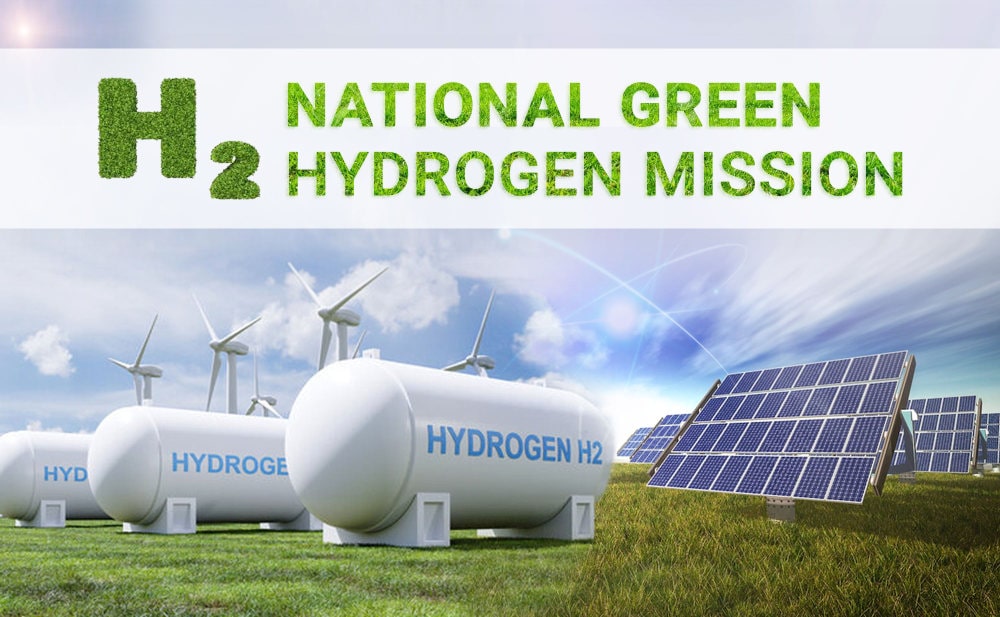

The National Green Hydrogen Mission represents India's ambition to emerge as a global leader in the production and export of green hydrogen. Initiated by the Union Cabinet on January 4, 2022, this mission aims to achieve a targeted production capacity of 5 million tonnes per annum of Green Hydrogen by 2030. Under this initiative, the Ministry of New and Renewable Energy (MNRE) introduced the SIGHT Programme – Component II to incentivize green ammonia production, catering specifically to the fertilizer sector.
On June 22, 2024 in response to an escalating demand, MNRE increased the annual allocation for green ammonia production from 5,50,000 to 7,50,000 tonnes per annum,highlighting its commitment to stimulate domestic demand for Green Hydrogen and its derivatives. This strategic approach not only promotes sustainable energy practices but also enhances India's position as a key player in global renewable energy solutions.
Mission Components
The National Green Hydrogen Mission is built on a multifaceted strategy designed to coordinate efforts across various sectors:
❖ Demand Creation: Making Indian-produced green hydrogen competitive both domestically and for export markets.
❖ Supply-side Interventions: Implementing incentive frameworks to address constraints in production and distribution.
❖ Building an Enabling Ecosystem: Supporting scaling and development through infrastructure and technological advancements.
Government has been making continuous efforts for increased production and usage of Green Hydrogen and Ammonia. Some of the recent initiatives that strengthened the National Green Hydrogen Mission are as follows
❖ The National Green Hydrogen Mission was approved by the Union Cabinet on 4th January, 2023, with an outlay of ₹19,744 crore.
❖ Recommendations on Regulations, Codes, and Standards for Green Hydrogen were shared by the Working Group chaired by Secretary, MNRE, on 8th May, 2023.
❖ The International Conference on Green Hydrogen (ICGH – 2023) took place in New Delhi from 5th to 7th July, 2023, featuring global participation from industry, academia, and government.
❖ The Green Hydrogen standard for India, defining emission thresholds for 'Green' classification, was notified on 19th August, 2023.
❖ On 7th October, 2023, the Green Hydrogen page was launched on the National Single Window System(NSWS) for project approvals.
❖ The Research & Development Roadmap for the National Green Hydrogen Mission was unveiled on 7th October, 2023.
❖ Scheme guidelines for SIGHT Modes 2A (Green Ammonia aggregation model) and 2B (Green Hydrogen aggregation model) were notified on 16th January, 2024.
❖ Contracts for Electrolyser Manufacturing under the SIGHT Scheme were awarded on 12th January, 2024, to 8 companies for a capacity of 1,500 MW per annum.
❖ On 9th January, 2024, contracts were awarded under the SIGHT Scheme for Green Hydrogen Production to 10 companies, totalling 4,12,000 tons per annum capacity.
❖ The bidding process for 5.39 lakh MT/annum of Green Ammonia production, aimed at supplying fertilizer companies, was initiated on 8th June, 2024.
❖ On 15th May, 2024, Secretary, MNRE addressed the World Hydrogen Summit 2024 in Rotterdam, highlighting India's capabilities in renewable energy and green hydrogen production.
❖ On 17th April, 2024, the Indian Renewable Energy Development Agency Ltd. (IREDA) opened an office in GIFT City, Gandhinagar, facilitating foreign currency-denominated debt options for green hydrogen and renewable energy projects.
❖ From 18th to 22nd March, 2024, India hosted the 41stInternational Partnership for Hydrogen and Fuel Cells in the Economy (IPHE) Meeting in New Delhi, fostering collaboration on clean hydrogen technologies.
❖ On 22nd June, 2024, the allocation for Green Ammonia production under the SIGHT Programme was increased to 7.5 lakh tonnes per annum.
These initiatives underscore India's commitment to becoming a global leader in green hydrogen and ammonia production, leveraging partnerships, robust regulatory frameworks, and substantial financial investments to drive sustainable development and energy independence.
Projected Impact
By 2030, the mission targets substantial milestones:
❖ Production Capacity: Aiming for a minimum of 5 million metric tonnes (MMT) of green hydrogen per annum, supported by an additional renewable energy capacity of approximately 125 GW.
❖ Investment and Economic Impact: Projected investments exceeding ₹8 lakh crore, showcasing substantial economic opportunities.
❖ Carbon Emissions Reduction: Anticipates averting nearly 50 MMT per annum of CO2 emissions, paving the way for achieving India's Net Zero goals.
Need for Green Hydrogen and Ammonia
India's commitment to achieve Net Zero emissions by 2070 underscores the urgency of transitioning towards sustainable energy sources. The nation's energy demand has seen exponential growth, with a projected increase of at least 25% by 2030. This growth has led to significant reliance on imported fossil fuels, particularly in sectors such as mobility and industrial production.
Hydrogen and Ammonia are envisaged to be the future fuels to replace fossil fuels. Production of these fuels by using power from renewable energy, termed as green hydrogen and green ammonia, is one of the major requirements towards environmentally sustainable energy security of the nation. Government of India is taking various measures to facilitate the transition from fossil fuel / fossil fuel based feed stocks to green hydrogen / green ammonia.
It can efficiently utilize India's abundant renewable resources across various sectors and geographies. From replacing fossil fuel-derived feedstocks in industries like petroleum refining and steel manufacturing to decarbonizing long-haul transportation and enabling energy independence for remote areas, green hydrogen offers versatile applications crucial for India's sustainable development goals.
The National Green Hydrogen Mission is poised to deliver widespread benefits across the economy:
❖ Decarbonization: Significant reductions in CO2 emissions from industrial, mobility, and energy sectors.
❖ Reduced Dependence on Imports: Diminished reliance on imported fossil fuels, enhancing energy security.
❖ Indigenous Manufacturing: Development of domestic capabilities in green hydrogen technology and infrastructure.
❖ Employment Opportunities: Creation of over 6 lakh jobs throughout the value chain, from production to utilization.
❖ Technological Innovation: Advancement of cutting-edge technologies and innovation ecosystems within the country.
References:
https://www.nsws.gov.in/portal/scheme/greenhydrogenpolicy
https://nghm.mnre.gov.in/index?language=en
https://www.india.gov.in/spotlight/national-green-hydrogen-mission
https://pib.gov.in/PressReleasePage.aspx?PRID=1799067
https://pib.gov.in/PressReleasePage.aspx?PRID=1992732
https://pib.gov.in/PressReleasePage.aspx?PRID=2008166
https://pib.gov.in/PressReleasePage.aspx?PRID=2003544
https://pib.gov.in/PressReleasePage.aspx?PRID=2016073
https://pib.gov.in/PressReleasePage.aspx?PRID=2018150
https://pib.gov.in/PressReleasePage.aspx?PRID=2023625
https://pib.gov.in/PressReleasePage.aspx?PRID=2027858
Article jointly authored by Santosh Kumar, Sarla Meena,Ritu Katari, MadihaIqbal & Anjali Gupta